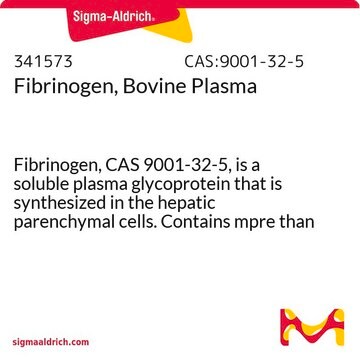F3879
Fibrinogen from human plasma
50-70% protein (≥80% of protein is clottable)
Sinónimos:
Factor I
About This Item
Productos recomendados
biological source
human plasma
form
powder
quality
50-70% protein (≥80% of protein is clottable)
mol wt
α-chain 63.5 kDa
β-chain 56 kDa
γ chain 47 kDa (about 4% carbohydrate content)
soluble dimer 340 kDa
concentration
50-70% protein (biuret)
technique(s)
ELISA: suitable
solubility
0.9% NaCl: soluble 10 mg/mL
storage temp.
−20°C
¿Está buscando productos similares? Visita Guía de comparación de productos
General description
Application
Fibrinogen was also used in the development of a fibrinogen-specific sandwich enzyme-linked immunosorbent assay microarray assay for distinguishing between blood plasma and serum samples.
Fibrinogen from human plasma has been used-
- for the production of fibrin hydrogels
- for the preparation of fibrin-MSCs (mesenchymal stem cells)-cartilage constructs
- for analyzing the protein repellent properties of PFDA-co-DEGDME (diethyleneglycol dimethyl ether) surface using Quartz crystal microbalance (QCM)
Biochem/physiol Actions
Specifications
Physical form
Reconstitution
Analysis Note
Disclaimer
Storage Class
11 - Combustible Solids
wgk_germany
WGK 3
flash_point_f
Not applicable
flash_point_c
Not applicable
ppe
Eyeshields, Gloves, type N95 (US)
Certificados de análisis (COA)
Busque Certificados de análisis (COA) introduciendo el número de lote del producto. Los números de lote se encuentran en la etiqueta del producto después de las palabras «Lot» o «Batch»
¿Ya tiene este producto?
Encuentre la documentación para los productos que ha comprado recientemente en la Biblioteca de documentos.
Los clientes también vieron
Nuestro equipo de científicos tiene experiencia en todas las áreas de investigación: Ciencias de la vida, Ciencia de los materiales, Síntesis química, Cromatografía, Analítica y muchas otras.
Póngase en contacto con el Servicio técnico









